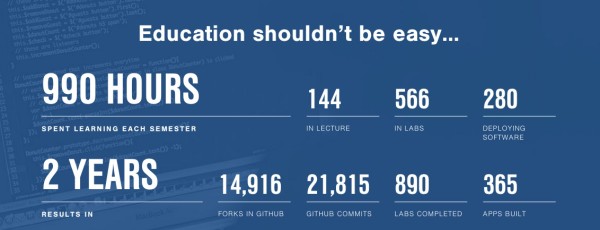The news is full of stories where students paid hundreds of thousands of dollars to go to college (and beyond) only to find themselves stuck in dead end jobs and unable to pay off the cost of student loans. We have a crisis in the US in higher education. The costs have risen and the benefits have declined.
It has gotten to the point where I believe if you have to personally shoulder the cost of your higher education, you should think twice about the traditional model. If you can get scholarships or if your parents are willing to pay the tuition bills, I still think its a valuable experience, but sadly it is not one that makes sense if you have to make the investment personally.
So what are we going to do about that? We need to find new models. And one new model that is working in NYC is The Flatiron School. The Flatiron School started two years ago and teaches students, both high school grads and college grads, how to become software engineers in a twelve week course that costs $15,000. Scholarships are available for students who cannot afford that investment.
Today The Flatiron School has published an audited report that validates the notion that their model produces graduates who can find high paying jobs. Here is a summary of the report and this is the “money slide” from it:

So for a high school graduate, the tuition at Flatiron can be paid back with six months of after tax income. For a college graduate, you can increase your pay by ~$30k by spending $15k. You get that payback in one year of after tax income.
For the average college grad, it takes roughly three years of all of your after tax income to pay off your college costs. If you go on and do Flatiron, you can pay off everything with two years of after tax income.
Anyway you cut the numbers, The Flatiron School is a great investment. Part of it is that the students learn a valuable skill – software development. Part of it is that the cost of delivering that education are very reasonable. And it isn’t that they do this on the cheap. Here is the work required from a student at The Flatiron School:

There’s been a lot of talk that online education is the answer to lowering the costs of higher education. The huge investment in MOOCS that happened a few years ago was based on that notion. The reality is that online education is a part of the answer but not the silver bullet that some thought it would be. I gave a talk at Wharton a couple years ago about this.
The answer to lowering the cost and increasing the benefits of higher education requires a multitude of changes to the current model. And one of them is teaching students skills that are directly related to job requirements. Doing that makes students more employable and more valuable.
This is not a criticism of the liberal arts model, per se. As Steve Jobs said in this interview, learning to code is a liberal art. This is a criticism of administrations and faculties that are rigid in their interpretation of what liberal arts and education should mean. This is a criticism of not evolving and changing with the times. This is a criticism of thinking what worked yesterday will work tomorrow.
And mostly this is a criticism of not making hard choices. Schools that are happy to add courses, faculty, and buildings are not willing to eliminate courses, faculty, and buildings. When you always add and never subtract, you get cost structures that are not sustainable.
The Flatiron School is an example of what can be done with a blank slate. They have figured out how to give students highly relevant and valuable skills at a cost that is both affordable and recoupable very quickly. Adam, Avi, Sara and the entire team has created a model that should be an inspiration for others.

